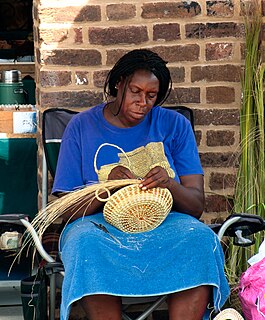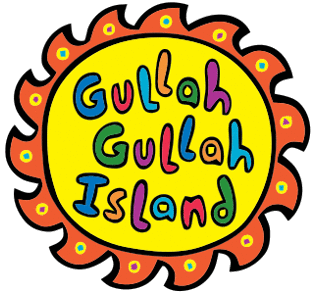
Gullah is a creole language spoken by the Gullah people, an African-American population living in coastal regions of South Carolina and Georgia as well as extreme northeastern Florida and the extreme southeast of North Carolina.

Hoodoo is a set of spiritual practices, traditions, and beliefs which were created and concealed from slaveholders by enslaved Africans in North America. Hoodoo evolved from various traditional African religions and practices, and in the American South, incorporated various elements of indigenous botanical knowledge. Hoodoo is an African Diaspora tradition created during the time of slavery in the United States, and is an esoteric system of African-American occultism. Many of the practices are similar to other African Diaspora traditions as the practices come from the Bakongo people in Central Africa. During the transatlantic slave trade, about 40 percent of Africans taken to the United States were Bantu-Kongo. Hoodoo is a syncretic spiritual system that combines Christianity, Islam brought over by enslaved West African Muslims, and Spiritualism. This tradition is part of the African-American cultural heritage of spirituality and religion. Following the Great Migration of African-Americans, Hoodoo spread throughout the United States. Practitioners of Hoodoo are called rootworkers, conjure doctors, conjure man or conjure woman, root doctors, Hoodoo doctors, and swampers. Regional synonyms for Hoodoo include conjure or rootwork.

The Gullah are an African American ethnic group who predominantly live in the Lowcountry region of the U.S. states of Georgia, Florida, South Carolina, and North Carolina, within the coastal plain and the Sea Islands. Their language and culture have preserved a significant influence of Africanisms as a result of their historical geographic isolation and the community's relation to their shared history and identity.

Daufuskie Island, located between Hilton Head Island and Savannah, is the southernmost inhabited sea island in South Carolina. It is 5 miles (8 km) long by almost 2.5 miles (4.0 km) wide – approximate surface area of 8 square miles (21 km2). With over 3 miles (5 km) of beachfront, Daufuskie is surrounded by the waters of Calibogue Sound, the Intracoastal Waterway and the Atlantic Ocean. It was listed as a census-designated place in the 2020 census with a population of 557.

The Lowcountry is a geographic and cultural region along South Carolina's coast, including the Sea Islands. The region includes significant salt marshes and other coastal waterways, making it an important source of biodiversity in South Carolina.

In the United States, A National Heritage Area (NHA) is a site designated by Act of Congress, intended to encourage historic preservation of the area and an appreciation of the history and heritage of the site. There are currently 55 NHAs, some of which use variations of the title, such as National Heritage Corridor.

Marquetta L. Goodwine is an author, preservationist, and performance artist who serves as Queen Quet, Chieftess of the Gullah/Geechee Nation.
Emory Campbell is a community leader among the Gullah people, African Americans who live in the coastal low country region of South Carolina and Georgia. The Gullahs have preserved more of their African linguistic and cultural heritage than any other black community in the US.

Atlantic Creole is a cultural identifier consisting of populations with ties to the transatlantic colonization of the Americas and the Early Modern colonization of Africa. Early in this colonization and settlement creoles populations and cultures began to form which primarily flourished in the Americas.

McLeod Plantation is a former slave plantation located on James Island, South Carolina, near the intersection of Folly and Maybank roads at Wappoo Creek, which flows into the Ashley River. The plantation is considered an important Gullah heritage site, preserved in recognition of its cultural and historical significance to African-American and European-American cultures.

Joseph A. Opala, OR is an American historian noted for establishing the "Gullah Connection," the historical links between the indigenous people of the West African nation of Sierra Leone and the Gullah people of the Low Country region of South Carolina and Georgia in the United States.

Sierra Leonean Americans are an ethnic group of Americans of full or partial Sierra Leonean ancestry. This includes Sierra Leone Creoles whose ancestors were African American Black Loyalists freed after fighting on the side of the British during the American Revolutionary War. Some African Americans trace their roots to indigenous enslaved Sierra Leoneans exported to the United States between the 18th and early 19th century. In particular, the Gullah people of partial Sierra Leonean ancestry, fled their owners and settled in parts of South Carolina, Georgia, and the Sea Islands, where they still retain their cultural heritage. The first wave of Sierra Leoneans to the United States, after the slavery period, was after the Sierra Leone Civil War in the 1990s and early 2000s. According to the American Community Survey, there are 34,161 Sierra Leonean immigrants living in the United States.

Gullah Gullah Island is an American musical children's television series that was produced by and aired on the Nick Jr. programming block on the Nickelodeon network from October 24, 1994, to April 7, 1998. The show was hosted by Ron Daise - now the vice president for Creative Education at Brookgreen Gardens in Murrells Inlet, South Carolina - and his wife Natalie Daise, both of whom also served as cultural advisors, and were inspired by the Gullah culture of Ron Daise's home of St. Helena Island, South Carolina, part of the Sea Islands.

Hog Hammock is an African-American community on Sapelo Island, a barrier island of the U.S. state of Georgia.
Cornelia Walker Bailey was a storyteller, writer, and historian who worked to preserve the Geechee-Gullah culture of Sapelo Island, Georgia.
Geechie is a word referring to the U.S. Lowcountry ethnocultural group of the descendants of West African slaves who retained their cultural and linguistic history, otherwise known as the Gullah people and Gullah language. It has been used as a nickname for persons originating out of this culture and ethnic group. The term derives from the name of the Ogeechee River, an area where many of them settled.
The Geechee or Gullah are African Americans who live in the Lowcountry region of the U.S. states of Georgia, Florida, and South Carolina.
The Gullah are African Americans who live in the Lowcountry region of the U.S. states of Georgia, Florida, and South Carolina.
Griffin Lotson is an African-American historian, born in Crescent, Georgia. He is a seventh-generation Gullah Geechee. He serves as a councilman and the mayor pro-tem in Darien, Georgia. He also manages the Geechee Gullah Ring Shouters. He is the national Federal Government vice-chairman and former treasurer of the federal Gullah Geechee Cultural Heritage Corridor Commission.

The Gullah are African Americans who live in the Lowcountry region of the U.S. states of Georgia, Florida, South Carolina, and North Carolina, in both the coastal plain and the Sea Islands. They developed a creole language, also called Gullah, and a culture with some African influence.
















